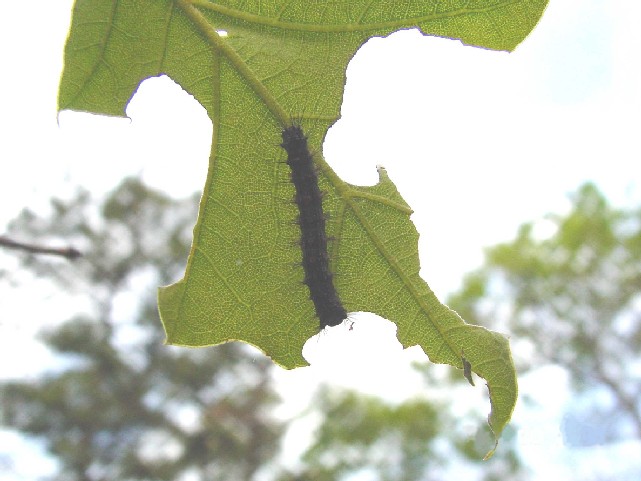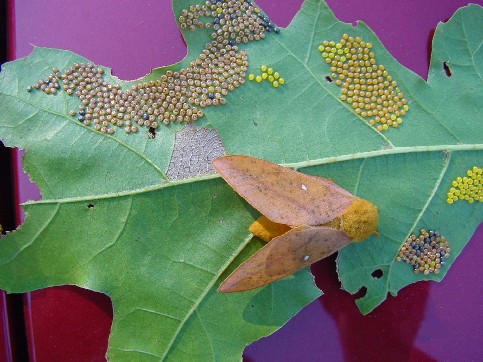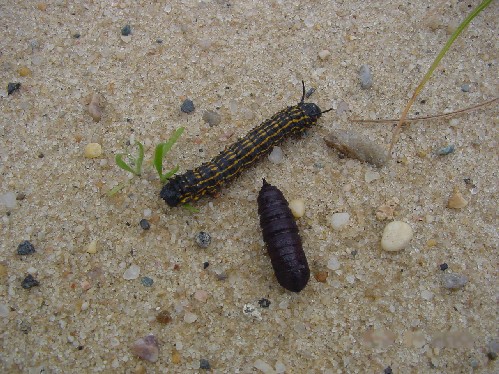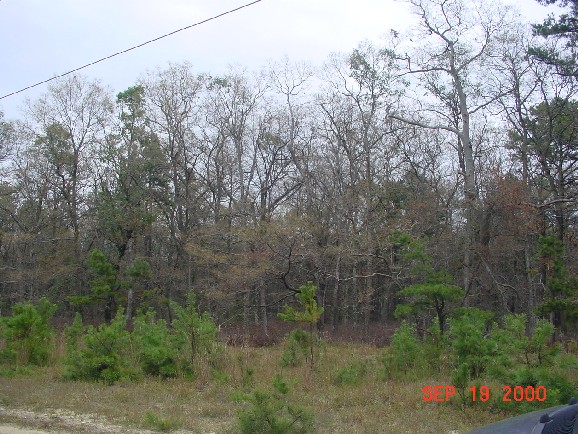Management Issues

Gypsy moth caterpillar on oak leaf.
BNL like many areas of Long Island has been noticing the effects of insect defoliators. There are two main defoliators that have been working on the oak forests of the Lab, gypsy moth (Lymantria dispar) and orange-striped oakmoth (Anisota senatoria).
The gypsy moth is a spring defoliator emerging from egg masses about the same time the oak trees are beginning to leaf out. The caterpillars feed on the new leaves through the month of June, then pupate and emerge as adults in late June or early July. Eggs are laid in a velvety mat on the trunks of trees and other vertical surfaces.

Orange-striped oak moth and eggs.
The orange-striped oak moth emerges as an adult beginning the first week of July. Females are poor fliers and generally climb up oak trees, release pheromones (insect perfume) to attract males. Males mate with the females, who then lay up to 500 eggs on the undersurface of oak leaves. Within 2 weeks the eggs have hatched and the army of oak worms begin devouring the leaves of the oaks. Observations suggest that there is a feeding preference for red oaks, but once all the foliage of the red oaks have been consumed the caterpillars will switch over to white and black oaks. Feeding lasts from July through September or early October at which time the caterpillars burrow under the forest leaf litter to pupate. The pupae over winter in the leaf litter to emerge as adults the following July.

Orange-striped oak moth caterpillar and pupa.
The long term effects of defoliation is not well documented. However, in the situation that has been occurring at BNL and other area of Long Island the effects may become evident within the next few years. The combined effects of repeated spring defoliation by the gypsy moth and late season defoliation by the orange-striped oak moth is likely going to result in the death of mature oaks. Certain areas of the Lab have had repeated defoliations for the past 4 years and likely several years prior to the first documentation of the oak worm on the Lab. This constant defoliation forces the trees to use energy reserves stored in the roots to survive winter and spring leaf out.

Effects of the orange-striped oak moth caterpillar. Notice the date is mid-September and there are no leaves on the oak trees
Unfortunately, the expenditure of energy is soon wasted as the leaves are eaten by the gypsy moth. Once the gypsy moth completes its cycle the trees have a few weeks to re-leaf just in time for the emergence of the orange-striped oakmoth caterpillar which, eats all of the leaves again. Thus the trees have spent years attempting to produce sugars and starches to restore the energy reserves in the roots. The result, death to sampling trees, and noticeable stress and the likely death of mature oaks.
What’s being done? Through the Upton Reserve research projects on the effects of the defoliators is being conducted. Researchers are also looking at the effects of prescribed fire on the survival of oak worm pupa. The Longwood High school has conducted a gypsy moth egg mass survey to plot the extent and density of the gypsy moth within the Upton Reserve. The U.S. Forest Service is also providing annual aerial surveys that will be used to map the extent of the defoliation and may eventually assist in combating the infestations if it is warranted.
Update
As of Fall 2004 it appears that the cycle of defoliation has been broken. We are not sure why the oak worm infestation has declined but speculate that a hard winter and cooler temperatures during June and July may have played a key role. The oak worm moth typically emerges around July 4-10. This past summer emergence did not occur until early August. The number of emerging moths was much lower than in past years. The lateness of egg laying and subsequent development of larvae pushed the pupation stage into late September and early October past the time of the first frost.
The results of repeated annual defoliate can readily be seen in the oak forests in the Pine Barrens around the Lab and east of the Lab. In much of the forest oak death is as high as 10% of trees. This has resulted in significant de-branching of trees during fall wind storms and heavy rains. Also, resulting from the defoliation is an increase in the sedge and grass understory.


